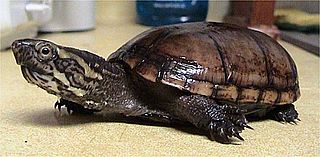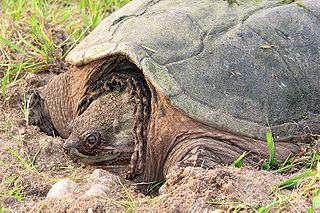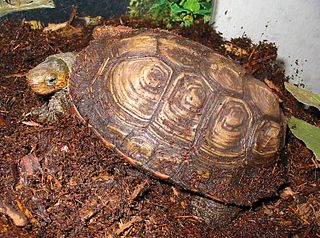James Lee Peters was an American ornithologist.

Dermochelyidae is a family of turtles which has seven extinct genera and one extant genus, including the largest living sea turtles.

Macrochelys is a genus of very large freshwater turtles in the family Chelydridae from Southeastern United States. Only a single extant species was recognized until a 2014 study divided it into two, or possibly three species.

Kinosternon is a genus of small aquatic turtles from the Americas known commonly as mud turtles.

Chelydra is one of the two extant genera of the snapping turtle family, Chelydridae, the other being Macrochelys, the much larger alligator snapping turtle. The snapping turtles are native to the Americas, with Chelydra having three species, one in North America and two in Central America, one of which is also found in northwestern South America.

Cyclanorbis is a genus of softshell turtles in the family Trionychidae. The genus is endemic to Africa.

The Bellinger River turtle, is a species of turtle in the family Chelidae. The species is of moderate size, and is endemic to Australia with a highly restricted distribution to the small coastal drainage of the Bellinger River in New South Wales. In the past the species was considered locally abundant. The species' preferred habitat is the deeper pools of the clear-water upstream reaches of the river, where water flows continuously in most months over a bedrock basement and a stream bed of boulders, pebbles, and gravel.

Mauremys is a genus of turtles in the family Geoemydidae.

The big-headed turtle is a species of turtle in the family Platysternidae from Southeast Asia and southern China.

Rhinoclemmys is a genus of turtles in the family Geoemydidae, the only genus in the subfamily Rhinoclemmydinae. Member species of the genus are commonly known as the Neotropical wood turtles and are the only geoemydids known from the Americas. As such, they have adapted to a wide range of habitats, which is reflected in the species' common names.
Bleasdalea is a genus of flowering plants in the family Proteaceae.
Chodsigoa is a genus of shrews in the tribe Nectogalini.

Chelonoidis is a genus of turtles in the tortoise family erected by Leopold Fitzinger in 1835. They are found in South America and the Galápagos Islands. They were formerly assigned to Geochelone, but a recent comparative genetic analysis has indicated that they are actually most closely related to African hingeback tortoises. Their ancestors apparently floated across the Atlantic in the Oligocene. This crossing was made possible by their ability to float with their heads up and to survive up to six months without food or water.

Placospermum is a genus of a single species of large trees, constituting part of the plant family Proteaceae. The species Placospermum coriaceum is endemic to the rainforests of the wet tropics region of northeastern Queensland, Australia. Common names include rose silky oak and plate-seeded oak.
Turrillia is a genus of plants in the family Proteaceae, native to Oceania.

Megalochelys is an extinct genus of cryptodiran tortoises that lived from the Miocene to Pleistocene, across Asia and possibly Eastern Europe. They are noted for their giant size, which is among the largest of any known testudine, with a maximum carapace length over 2 m in M. atlas.

Centrochelys is a genus of tortoise. It contains one extant species and several extinct species:
Epiperipatus biolleyi is a species of velvet worm in the Peripatidae family. The type locality is in Costa Rica.
Opisthopatus cinctipes is a species of velvet worm in the Peripatopsidae family. The type locality is in South Africa.
Phrynops paranaensis is an extinct species of turtle from the Huayquerian Ituzaingó Formation of the Paraná Basin, Argentina, likely to be late Miocene in origin.
This page is based on this
Wikipedia article Text is available under the
CC BY-SA 4.0 license; additional terms may apply.
Images, videos and audio are available under their respective licenses.












